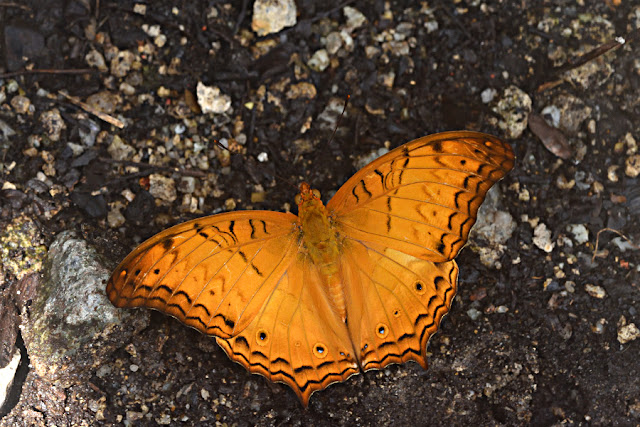In the past two months (May and June 2019), I visited Dairy Farm Park on a few Sunday mornings either hiking up to the peak of our highest mountain or just for butterfly-hunting.
Good to see a lot more people came to the park these days - in fact, many bird watchers and photographers always gathered at the furthest entrance point of the Wallace Trail. I was told that that area was good for watching and shooting birds.
On one particular Sunday morning in early May, I came out from the Wallace Trail and moved towards Car Park B. At the open space near the Wallace Education Centre, I noticed a small lycaenid fluttering rather weakly in the air. I had no clue about what it was. Out of curiosity, I watched and followed it closely until it landed - I was very surprised to see a rather pristine Logania marmorata damis (The Pale Mottle) rested on a tiny rock - this is not the usual hehaviour shown by this species.
There were a few small Blues fluttering at the ground level near the toilet at Car Park B. With patience, I managed to snapped some shots. I was particularly excited to shoot a Four-line Blue as I have not seen one for a long time.
In fact, this shot generated very profound discussions about its identity - whether it is the Nacaduba hermus or the N. pendleburyi in ButterflyCircle Forum here.
If you observe carefully, you notice that this Nacaduba species has 6 white lines in the forewing. This is perhaps a Rounded Six-line Blue (Nacaduba berenice icena).
Another Nacaduba species was shot in early June outside the toilet. Noticing the differences in the white striae, I suspect this is the N. beroe neon.
Another look-alike lycaenid, this is Jamides alecto ageladas (The Metallic Caerulean) also found puddling on the ground.The blue iridescence on the upperside wings could be seen on this shot.
This Bush Brown, perhaps the Mycalesis mineus macromalayana was "hopping" around along a row of shrubs in front of the Wallace Education Centre. I ignored it until it perched on a nice position; long enough for me to snap a quick shot.
This small tailed lycaenid was found puddling at a muddy spot along the Wallace Trail. The ochreous straie on both wings are the characteristics of the Common Line Blue (Prosotas nora superdates.)
Same background but a different butterfly from the same genus, this is a very common lycaenid called the Tailess Line Blue (Prosotas dubiosa lumpura).
Another look-alike, but this is from another genus - the Ionolyce helicon merguiana (The Pointed Line Blue) is quite common in forested areas. Correction - this is another N. beroe neon (Thanks Dr Seow from ButterflyCircle)
Whenever a common forest shrub named Leea indica is flowering, its tiny white flowers would attract butterflies. This is Tagiades japetus atticus (Common Snow Flat) feeding on the small flowers.
A Large Snow Flat (Tagiades gana gana) also found on the same tree, feeding voraciously on the flowers.
This was my first sighting of an elegant butterfly at Dairy Farm Park, the Royal Assyrian (Terinos terpander robertsia) - a rather uncommon forest denizen. Being too active and skittish, it never presented me a nice and nearer perch for me to take better shots.
An upperside shot.
The Cruiser (Vindula dejone erotella) is a large forest butterfly from the nymphalidae family. The male likes to puddle on the moist ground.
This dark brown skipper, The Banded Demon (Notocrypta paralysos vrians) is a very fast flyer but it tends to perch quite frequently. This is a record shot when it rested on a high perch in a shady area.Another common skipper the Palm Bob (Suastus gremius gremius) , much smaller than the Banded Demon.
Lastly, two non-butterfly shots a tiny beetle and a snail to wrap up this long-overdue blog post.


















No comments:
Post a Comment